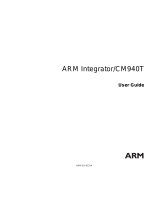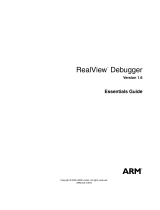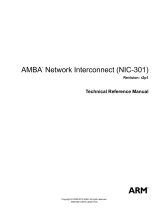Page is loading ...

Copyright © 2001-2003. All rights reserved.
ARM DUI 0163B
Integrator/IM-AD1
User Guide

ii Copyright © 2001-2003. All rights reserved. ARM DUI 0163B
Integrator/IM-AD1
User Guide
Copyright © 2001-2003. All rights reserved.
Release Information
Proprietary Notice
Words and logos marked with
®
or
™
are registered trademarks or trademarks owned by ARM Limited, except
as otherwise stated below in this proprietary notice. Other brands and names mentioned herein may be the
trademarks of their respective owners.
Neither the whole nor any part of the information contained in, or the product described in, this document
may be adapted or reproduced in any material form except with the prior written permission of the copyright
holder.
The product described in this document is subject to continuous developments and improvements. All
particulars of the product and its use contained in this document are given by ARM in good faith. However,
all warranties implied or expressed, including but not limited to implied warranties of merchantability, or
fitness for purpose, are excluded.
This document is intended only to assist the reader in the use of the product. ARM Limited shall not be liable
for any loss or damage arising from the use of any information in this document, or any error or omission in
such information, or any incorrect use of the product.
Confidentiality Status
This document is Non-Confidential. The right to use, copy and disclose this document may be subject to
license restrictions in accordance with the terms of the agreement entered into by ARM and the party that
ARM delivered this document to.
Product Status
The information in this document is final, that is for a developed product.
Web Address
http://www.arm.com
Date Issue Change
Oct 2001 A New document
Nov 2003 B Second release with minor corrections

ARM DUI 0163B Copyright © 2001-2003. All rights reserved. iii
Conformance Notices
This section contains conformance notices.
Federal Communications Commission Notice
This device is test equipment and consequently is exempt from part 15 of the FCC Rules under section 15.103
(c).
CE Declaration of Conformity
The system should be powered down when not in use.
The Integrator generates, uses, and can radiate radio frequency energy and may cause harmful interference to
radio communications. However, there is no guarantee that interference will not occur in a particular
installation. If this equipment causes harmful interference to radio or television reception, which can be
determined by turning the equipment off or on, you are encouraged to try to correct the interference by one
or more of the following measures:
• ensure attached cables do not lie across the card
• reorient the receiving antenna
• increase the distance between the equipment and the receiver
• connect the equipment into an outlet on a circuit different from that to which the receiver is connected
• consult the dealer or an experienced radio/TV technician for help.
Note
It is recommended that wherever possible Shielded interface cables be used.

iv Copyright © 2001-2003. All rights reserved. ARM DUI 0163B

ARM DUI 0163B Copyright © 2001-2003. All rights reserved. v
Contents
Integrator/IM-AD1 User Guide
Preface
About this book ............................................................................................ viii
Feedback ....................................................................................................... xi
Chapter 1 Introduction
1.1 About the Integrator/IM-AD1 ....................................................................... 1-2
1.2 Interface module features and architecture ................................................. 1-4
1.3 Links and LEDs ........................................................................................... 1-6
1.4 Care of modules .......................................................................................... 1-7
Chapter 2 Getting Started
2.1 Fitting the interface module ......................................................................... 2-2
2.2 Setting up the logic module ......................................................................... 2-3
2.3 Running the test software ........................................................................... 2-4
Chapter 3 Hardware Reference
3.1 Differences in signal routing between supported logic modules ................. 3-2
3.2 UART interface ........................................................................................... 3-3
3.3 SPI .............................................................................................................. 3-5
3.4 PWM interface ............................................................................................ 3-6
3.5 Stepper motor interface .............................................................................. 3-8
3.6 GPIO ......................................................................................................... 3-12

Contents
vi Copyright © 2001-2003. All rights reserved. ARM DUI 0163B
3.7 CAN interface ........................................................................................... 3-14
3.8 ADC and DAC interfaces .......................................................................... 3-18
Chapter 4 Reference Design Example
4.1 About the design example .......................................................................... 4-2
4.2 Example APB register peripheral ............................................................... 4-8
4.3 UART ........................................................................................................ 4-13
4.4 SPI chip select register ............................................................................. 4-14
4.5 Synchronous serial port ............................................................................ 4-15
4.6 PWM controller ......................................................................................... 4-16
4.7 Stepper motor peripheral .......................................................................... 4-17
4.8 GPIO ......................................................................................................... 4-21
4.9 SSRAM interface ...................................................................................... 4-23
4.10 Vectored interrupt controller ..................................................................... 4-24
4.11 CAN controller interface ........................................................................... 4-26
4.12 ADC and DAC interface ............................................................................ 4-27
4.13 Peripheral information block ..................................................................... 4-28
Appendix A Signal Descriptions
A.1 EXPA .......................................................................................................... A-2
A.2 EXPB .......................................................................................................... A-4
A.3 EXPIM ........................................................................................................ A-6
A.4 Logic analyzer connector ............................................................................ A-8
A.5 Multi-ICE (JTAG) ...................................................................................... A-10
Appendix B Mechanical Specification
B.1 Mechanical information ............................................................................... B-2
B.2 Connector reference ................................................................................... B-4
Glossary

Preface
viii Copyright © 2001-2003. All rights reserved. ARM DUI 0163B
About this book
This book provides user information for the ARM Integrator/IM-AD1 interface module.
It describes the major features and how to use the interface module with an Integrator
development platform.
Intended audience
This book is written for all developers who are using an Integrator/LM logic module to
develop ARM-based devices. It assumes that you are an experienced developer, and that
you are familiar with the ARM development tools.
Using this book
This book is organized into the following chapters:
Chapter 1 Introduction
Read this chapter for an introduction to the Integrator/IM-AD1 interface
module. This chapter describes the main features of the interface module
and identifies the main components.
Chapter 2 Getting Started
Read this chapter for information about preparing the interface module
for use with a logic module and Integrator/AP motherboard.
Chapter 3 Hardware Reference
Read this chapter for a description of the interface module hardware.
Chapter 4 Reference Design Example
Read this chapter for a description of the example logic module
configuration supplied that enables you to experiment with the interface
module.
Appendix A Signal Descriptions
Read this appendix for connector pinout information.

Preface
ARM DUI 0163B Copyright © 2001-2003. All rights reserved. ix
Typographical conventions
The following typographical conventions are used in this book:
italic Highlights important notes, introduces special terminology,
denotes internal cross-references, and citations.
bold Highlights interface elements, such as menu names. Denotes
ARM processor signal names. Also used for terms in descriptive
lists, where appropriate.
monospace
Denotes text that can be entered at the keyboard, such as
commands, file and program names, and source code.
monospace
Denotes a permitted abbreviation for a command or option. The
underlined text can be entered instead of the full command or
option name.
monospace
italic
Denotes arguments to commands and functions where the
argument is to be replaced by a specific value.
monospace
bold
Denotes language keywords when used outside example code.
Further reading
This section lists publications from both ARM Limited and third parties that provide
additional information on developing code for the ARM family of processors.
ARM periodically provides updates and corrections to its documentation. See
http://www.arm.com
for current errata sheets and addenda.
See also the ARM Frequently Asked Questions list on the ARM web site.
ARM publications
The following documents provide information about related Integrator products:
• ARM Integrator/AP User Guide (ARM DUI 0098)
• ARM Integrator/CM9x6E-S User Guide (ARM DUI 0138)
• ARM Integrator/CM920T-ETM User Guide (ARM DUI 0149)
• ARM Integrator/CM9x0T and CM7x0T User Guide (ARM DUI 0157)
• ARM Integrator/CM7TDMI User Guide (ARM DUI 0126)
• ARM Integrator/LM-XCV600E+ and LM-EP20K600E+ User Guide
(ARM DUI 0146).

Preface
x Copyright © 2001-2003. All rights reserved. ARM DUI 0163B
The following publications provide information about ARM PrimeCell devices that can
be used to control some of the interfaces described in this manual:
• ARM PrimeCell UART (PL011) Technical Reference Manual (ARM DDI 0183)
• ARM PrimeCell Synchronous Serial Port Master and Slave (PL022) Technical
Reference Manual (ARM DDI 0194)
• ARM PrimeCell DC-DC Converter Interface (PL160) Technical Reference
Manual (ARM DDI 0147)
• ARM PrimeCell Vectored Interrupt Controller (PL190) Technical Reference
Manual (ARM DDI 0181).
The following publications provide reference information about ARM architecture:
• AMBA Specification (ARM IHI 0011)
• ARM Architectural Reference Manual (ARM DDI 0100).
The following publications provide information about the ARM Developer Suite:
• Getting Started (ARM DUI 0064)
• ADS Tools Guide (ARM DUI 0067)
• ADS Debuggers Guide (ARM DUI 0066)
• ADS Debug Target Guide (ARM DUI 0058)
• ADS Developer Guide (ARM DUI 0056)
• ADS CodeWarrior IDE Guide (ARM DUI 0065).
The following publication provides information about Multi-ICE:
• Multi-ICE User Guide (ARM DUI 0048).
Third-party documents
The following documents provide information about third-party components used on
the Integrator/IM-AD1:
• CC770 Stand Alone CAN Controller Target Specification
Robert Bosch GmbH
• L6506 L6506D Current Controller For Stepping Motors
SGS-Thomson Microelectronics
• L298 Dual Full Bridge Driver
SGS-Thomson Microelectronics
• AD7859 Datasheet
Analog Devices, Inc.
• AD5342 Datasheet
Analog Devices, Inc.

Preface
ARM DUI 0163B Copyright © 2001-2003. All rights reserved. xi
Feedback
ARM Limited welcomes feedback on both the Integrator/IM-AD1 and its
documentation.
Feedback on this document
If you have any comments on this book, please send email to
giving:
• the document title
• the document number
• the page number(s) to which your comments apply
• a concise explanation of your comments.
General suggestions for additions and improvements are also welcome.
Feedback on the Integrator/IM-AD1
If you have any comments or suggestions about this product, please contact your
supplier giving:
• the product name
• an explanation of your comments.

Preface
xii Copyright © 2001-2003. All rights reserved. ARM DUI 0163B

ARM DUI 0163B Copyright © 2001-2003. All rights reserved. 1-1
Chapter 1
Introduction
This chapter introduces the Integrator/IM-AD1. It contains the following sections:
• About the Integrator/IM-AD1 on page 1-2
• Interface module features and architecture on page 1-4
• Links and LEDs on page 1-6
• Care of modules on page 1-7.

Introduction
1-2 Copyright © 2001-2003. All rights reserved. ARM DUI 0163B
1.1 About the Integrator/IM-AD1
The Integrator/IM-AD1 is an interface module that is designed to be used in conjunction
with the Integrator/LM-XCV600E+ or LM-EP20K600E+ and future compatible logic
modules. It provides several standard automotive and industrial interfaces, and can be
used for:
• proof of concept and application development
• benchmarking
• PrimeCell development and testing
• SoC prototyping.
The interface module is designed to be mounted on top of the logic module and provides
connectivity for peripherals in the logic module FPGA.
Figure 1-1 on page 1-3 shows the layout of the IM-AD1 and identifies the connectors.
The IM-AD1 can be used to implement additional peripherals to aid software
development, for example additional timers or a vector interrupt controller. The
IM-AD1 product consists of:
• a fully populated PCB
• example bit files for an LM
• example driver source code
• this documentation.

Introduction
ARM DUI 0163B Copyright © 2001-2003. All rights reserved. 1-3
Figure 1-1 Integrator/IM-AD1 layout
CONFIG LED
Serial port
(J18)
Logic analyzer
(J7)
GPIO A
(J17)
GPIO B
(J16)
A/D Inputs
(J1)
D/A Outputs
(J2)
SPI1
(J11)
SPI2
(J13)
Stepper motor
control
(J19 and J20)
Stepper motor
control
(J21 and J22)
PWM
(J14 and J10)
CAN
(J3A and J3B))
CONFIG link
(J8)
Multi-ICE
(J9)
CAN
(J3A and J3B)

Introduction
1-4 Copyright © 2001-2003. All rights reserved. ARM DUI 0163B
1.2 Interface module features and architecture
This section describes the main features of the interface module and its architecture.
1.2.1 Features
The main features of the interface module are as follows:
• two Bosch CC770 Controller Area Network (CAN) controllers
• two 8-channel 12-bit Analog to Digital Converters (ADC) with 200ksamples/s
sampling rate and 0-5V buffered inputs
• two 12-bit Digital to Analog Converter (DAC) channels with 0-5V outputs
• two L298 stepper motor drivers configured for bipolar motors
• two stepper motor control outputs for use with off-board drivers
• two 3A MOSFETs configured as switches for the Pulse Width Modulated (PWM)
outputs
• RS232 serial transceiver
• two 32-bit General Purpose Input Output (GPIO) connectors
• JTAG (Multi-ICE) pass-through connector
• logic analyzer connector connected to the GPIO bus.

Introduction
ARM DUI 0163B Copyright © 2001-2003. All rights reserved. 1-5
1.2.2 Architecture
Figure 1-2 shows the architecture of the interface module. For more detail on signal
routing between the expansion connectors and the interface circuits, see Chapter 3
Hardware Reference.
Figure 1-2 Integrator/IM-AD1 block diagram
J3A
J3B
J19
J23
Stepper motor
interfaces
D to A converter
A to D converter
J2
J1
UART interface
CAN interfaces
J14
J18
EXPA
socket
EXPIM
socket
J10
PWMs
J17
J16
SERIAL
GPIOA
GPIOB
DC/
PWM1
DC/
PWM2
A/D
IN
D/A OUT
CAN2
CAN1
STEP2
STEP1
EXPB
socket
J11
J13
SPI1
SPI2
J21
J22
STEP3
STEP4

Introduction
1-6 Copyright © 2001-2003. All rights reserved. ARM DUI 0163B
1.3 Links and LEDs
The interface module provides one link and one LED. These are the CONFIG link and
CONFIG LED.
Fitting the CONFIG link places all of the modules in the stack on which the interface
module is mounted into CONFIG mode. This mode enables you to reprogram the FPGA
image in the configuration flash on the logic module(s) using Multi-ICE (see the user
guide for the logic module).
The CONFIG LED lights to indicate when the stack is in CONFIG mode.

Introduction
ARM DUI 0163B Copyright © 2001-2003. All rights reserved. 1-7
1.4 Care of modules
This section contains advice about how to prevent damage to your Integrator modules.
Caution
To prevent damage to your Integrator system, observe the following precautions:
• When removing a core or logic module from a motherboard, or when separating
modules, take care not to damage the connectors. Do not apply a twisting force to
the ends of the connectors. Loosen each connector first before pulling on both
ends of the module at the same time.
• Use the system in a clean environment and avoid debris fouling the connectors on
the underside of the PCB. Blocked holes can cause damage to connectors on the
motherboard or module below. Visually inspect the module to ensure that
connector holes are clear before mounting it onto another board.
• Observe ElectroStatic Discharge (ESD) precautions when handling any
Integrator board.
Integrator/IM Interface Modules are designed to connect with ARM and third party
development platforms that meet the interface specification. Interface Modules connect
to the top of a stack because there are no EXPA/B connectors on the top side.

Introduction
1-8 Copyright © 2001-2003. All rights reserved. ARM DUI 0163B
/







